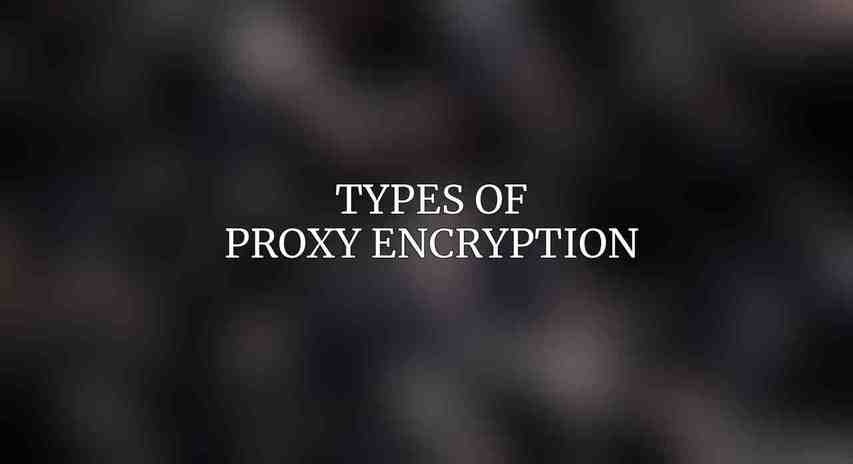Proxy encryption is a crucial cryptographic technique that enhances data security and privacy in communication systems. By utilizing proxy servers to handle encryption and decryption operations on behalf of end-users, this method adds an additional layer of protection to sensitive information. The primary purpose of proxy encryption is to safeguard data in transit and at rest from unauthorized access or interception. Its history dates back to the early development of secure communication protocols and has evolved significantly to meet the increasing demands for confidentiality and integrity in modern computing environments.
Types of Proxy Encryption

A. Type-I Proxy Re-Encryption
Type-I proxy re-encryption involves transforming ciphertext encrypted under one key into another key without revealing the plaintext. This process maintains data confidentiality while allowing for secure key delegation. Various schemes and algorithms, such as Elliptic Curve Cryptography (ECC) and Advanced Encryption Standard (AES), are commonly used to implement Type-I proxy re-encryption, ensuring robust security features and efficient key management.
B. Type-II Proxy Re-Encryption
Type-II proxy re-encryption builds upon Type-I techniques but introduces additional properties, such as the ability to re-encrypt data multiple times and support for more complex access control policies. The schemes and algorithms associated with Type-II proxy re-encryption focus on optimizing performance and scalability while preserving the confidentiality and integrity of encrypted data.
C. Proxy Encryption without Keyword Search
Proxy encryption without keyword search concentrates on protecting data without the need for keywords or search functionality. This approach emphasizes data security and access control mechanisms that do not rely on specific search queries, enabling a broader range of applications and use cases in secure communication systems.
Key Generation and Distribution
Key generation in proxy encryption involves creating cryptographic keys that are utilized for encrypting and decrypting data. The process of key distribution and management ensures that authorized parties receive the necessary keys securely and can access encrypted information as needed. Trust models and security assumptions play a vital role in establishing the foundation for secure key exchange and management, mitigating potential risks and vulnerabilities in proxy encryption systems.
Proxy Encryption Schemes
Proxy encryption schemes encompass various cryptographic protocols and methodologies designed to secure data transmission and storage.
| Scheme | Description |
|---|---|
| Identity-Based Proxy Re-Encryption | Implements CP-ABE and KP-ABE schemes for secure data access |
| Attribute-Based Proxy Re-Encryption | Utilizes ABE-CP-PRE and KP-HABE-PRE schemes for enhanced access control |
| Revocable Proxy Re-Encryption | Deploys RPRE and Efficient RPRE schemes to enable key revocation and management |
These schemes offer tailored solutions for different security requirements and access control policies, catering to diverse applications in cloud computing, social networking, healthcare, and e-commerce sectors.
Applications of Proxy Encryption
Proxy encryption finds extensive applications in various domains, including: Learn more about 2024’s Top Proxy Services for Ensuring Your Digital Privacy
- Secure Cloud Storage and File Sharing: Protecting sensitive data stored or shared in cloud environments.
- Social Networks and Messaging Apps: Ensuring privacy and confidentiality in online communication platforms.
- Healthcare and Electronic Health Records: Safeguarding personal health information and medical records.
- E-commerce and Online Banking: Securing financial transactions and sensitive customer information.
These applications demonstrate the versatility and adaptability of proxy encryption in addressing the evolving security challenges in this digital world.
Advantages and Disadvantages of Proxy Encryption
A. Benefits
- Enhanced Data Privacy and Control: Proxy encryption empowers users to maintain control over their data while ensuring privacy and confidentiality.
- Flexible Access Control: Enables fine-grained access policies and dynamic user permissions for secure data sharing.
- Scalability and Efficiency: Streamlines key management processes and enhances performance scalability in distributed systems.
B. Challenges
- Key Management Complexity: Managing cryptographic keys securely and efficiently poses challenges in large-scale proxy encryption systems.
- Trust Issues and Security Risks: Establishing trust relationships and mitigating potential security vulnerabilities are ongoing concerns.
- Revocation and Delegation: Addressing key revocation mechanisms and delegation issues requires careful design and implementation to maintain system integrity.
Future Directions and Research

A. Quantum-Safe Proxy Encryption
As quantum computing technologies advance, research focuses on developing quantum-safe proxy encryption schemes to resist attacks from quantum adversaries and ensure long-term data security.
B. Fine-Grained Access Control with Proxy Encryption
Enhancing access control mechanisms to provide finer granularity and flexibility in defining data access policies using proxy encryption techniques.
C. Proxy Encryption for Federated Learning and Data Analytics
Exploring the application of proxy encryption in federated learning settings and data analytics platforms to protect data privacy and confidentiality during collaborative data processing.
Proxy encryption plays a vital role in enhancing data security and privacy in modern computing environments. By leveraging advanced cryptographic techniques and secure key management practices, proxy encryption offers a robust solution for safeguarding sensitive information in diverse applications. Ongoing developments in proxy encryption research and its potential future prospects showcase its importance in mitigating security risks and ensuring the integrity of data in digital communication systems.
Frequently Asked Questions
What is proxy encryption?
Proxy encryption is a technique where a proxy server encrypts data before transmitting it to the receiving server, adding an additional layer of security.
How does proxy encryption protect data?
Proxy encryption helps protect data by encrypting it at the proxy server, making it unreadable to anyone who might intercept the data during transmission.
What are the benefits of using proxy encryption?
Some benefits of using proxy encryption include enhanced security, protection against data breaches, and the ability to access geo-restricted content safely.
Is proxy encryption easy to set up and use?
Setting up proxy encryption can vary in complexity depending on the type of proxy server and encryption method used, but once properly configured, it can be relatively easy to use. Read more about this on Top Secure Proxy Usage Practices for Ultimate Online Privacy
Can proxy encryption be used for all types of data transmission?
Proxy encryption can be used for various types of data transmission, including web browsing, file sharing, and messaging services, providing a versatile solution for protecting sensitive information.

